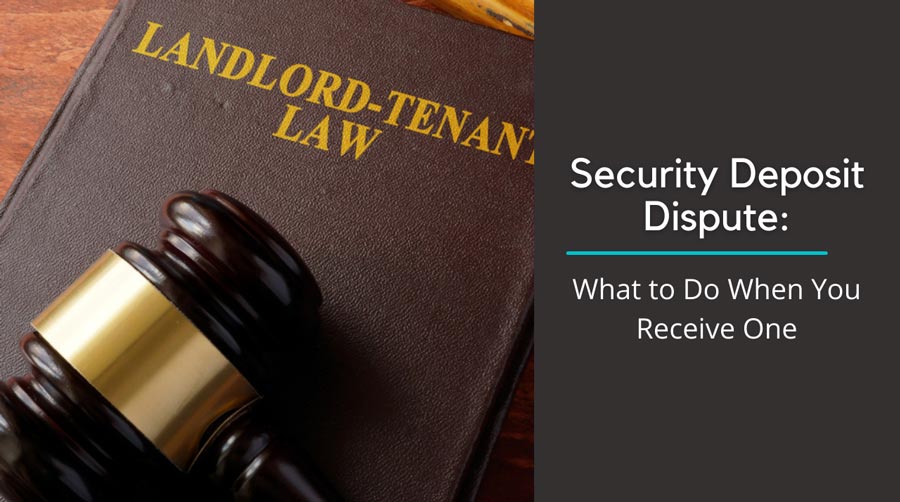
Security Deposit Dispute: What to Do When You Receive One
Owners and residents often have questions regarding security deposit refunds. The questions often center around the actual deductions noted on the security deposit breakdowns. Thus, the dreaded security deposit dispute.
Here at Management One, we must walk a fine line between both the homeowners and the residents. Both sides feel entitled to the funds.
As an owner, it is important to resolve the security deposit dispute in a timely manner to avoid the situation from escalating. In this article, we will discuss some of the most important things to consider when making deductions to the security deposit and how to avoid a legal battle over it.
Table of Contents
Evaluating Damages vs. Normal Wear & Tear: Following Legal Guidelines
Many owners get confused on what kinds of things can be charged as damage and what the law says regarding these, creating a security deposit dispute.
For example:
- Paint. Painting costs often play a role on those security deposit breakdowns, and it can be a fine line to cross in assessing what kinds of charges should be transferred to the resident. The rate of charges will depend on how long the resident has been in the home.
- Cleaning is also an item that is often in dispute, whether it be a partial or a full cleaning, interior or exterior. As this item is very subjective, the rule of thumb is they are to “return the home in the condition in which they received it.” It is also important to be in compliance with federal and state regulations, as well as being informed of Fair Housing Law and recommendations. In the case of a security deposit dispute, you will need to prove that you have a legal right to the funds being withheld and advise the resident of such.
Here is a great article pertaining to California Fair Housing’s Guidelines. It provides recommendations for navigating the owner-resident relationship. See pages 59-61 for more information on security deposits.
Providing Proof for Charges
For any repair or cleaning charge, it is best to have before and after pictures that substantiate the charges. This tends to be the most effective method to dissipate disputes since it provides a “black and white” approach to the issue.
Make sure to take a thorough video or plenty of pictures of every aspect of the property right before they move in as well as immediately after they have vacated the premises.
When assessing damages, review those pictures or videos and compare them. Would it be attributed to normal wear and tear, or did they just make a hole in the wall and left it?
This is the single most powerful tool you have for resolving disputes.
Estimate vs. Invoice
Depending on your state laws, you might be able allowed to provide residents with a “good faith estimate” for the charges made against their security deposit. This is in case you have not been able to hire a contractor and complete the repairs before the deadline to send the security deposit back to the resident expires. Things happen, and sometimes those numbers get adjusted and you might need to give them a refund for an item.
If possible, always go with receipts or invoices of work completed for which funds were retained. This helps give transparency to the process and show the legitimacy of the amount being charged.
Legal Action Threats
So, what do you do if you’ve followed all of the items above and you are still not able to resolve the matter? At this point, you have:
- confirmed you are in compliance with state, federal, and fair housing laws
- have shown before and after pictures of the damages
- proved legal right to retain funds
- provided proof of repairs completed (via invoices)
And they are still disputing!?
Sometimes certain people just want to take it all the way to legal thinking either they can bully a person into it or they have other situations regarding the tenancy they feel they can use as leverage, or any other reason out there.
Your Options
It’s everyone’s right to bring these matters up to small claims court if they feel they have been wronged and want a judge to decide. That is the way it has been set up.
There are two options here:
1. Settle the Security Deposit Dispute
This would obviously depend on the amount. If the amount is small enough that it compensates for the trouble of going spending a day in court you might decide to do so.
It doesn’t have to be just you settling to give back the full amount, sometimes during the dispute process, you are able to get them to settle on some of the charges. It is an art of “give and take,” but this also depends on what kind of attitude the resident brings to the table.
Some residents are just “my way or the highway,” but most of the time with the support of pictures and video as well as settling in some areas will show them cooperation and they will be more likely to “give in” as well.
Settling can occur on one or both sides, and it can happen before or during court.
However, if the amount they owe is high, it might be beneficial for you to spend the day in court and get a judgment if funds are still owed to you on the security deposit.
2. Take it to Court
If you have tried all of the above and they are still unhappy, the next step would be for them to sue you in court.
In California, you are obligated to attend a mediation meeting with the person who is suing you before the judge hears the case. This is the last chance there is to resolve the matter before it is taken to the higher authority, the judge. Check your state laws on how this process works in your state.
Court Mediation for a Security Deposit Dispute
Court mediation is much like being in front of the judge. During court mediation, the court-appointed mediator will ask both sides to share their side of the story. This is to be done in a respectful manner and without interrupting each other, just like the judge would. The mediator is an independent party who is completely impartial, and they are there only to help both parties achieve an agreement before going in front of the judge.
After each party has given their side of the story, they are asked to share with each other any pertinent information regarding the case and claims being made for both parties to see. Once that documentation is shared, you might discover there is some documentation you didn’t account for, or proof you are lacking, or any other mistake either on your end or theirs that can help move the case along to the resolution phase.
Once all items have been thoroughly discussed, it is time for the final chance to settle. As mentioned before, after taking a look at all the documentation brought to court, which might end up in the judge’s hands, you might find that it would be better for you to settle or for them to settle with you. A call for settlement will be made by the mediator who will bring up key issues and ask if a settlement can be reached.
Final Say: The Judge
If all else fails and you find yourself in this position, no need to panic (as long as you have complied with everything above). Sometimes you encounter people that you are just unable to please no matter how hard you try and how legal and right it is. That is what judges are there for, to resolve these matters.
Like mentioned before, be sure to have all necessary information with you.
- Be organized: bring items separated, tabulated, and organized in order of priority. I recommend you keep all items regarding the specific items in dispute first and any other items related to the tenancy that are not in security deposit dispute later.
- Take printed pictures: Pictures are preferred by most courts over video. Sometimes courts don’t have the capabilities to show videos, and some judges feel like playing the video on a phone doesn’t give full clarity or allows for disadvantages to either party. Print the pictures out and bring them with you.
- Take any and all invoices of work completed before, during and after the resident’s tenancy.
- Take move in/move out inspections if you have them.
- Take the entire file! You never know what you’re going to need. Sometimes people will mention things that were not even part of the dispute you want to make sure you are prepared for anything that can be sent your way.
No Resolution
After the unsuccessful mediation meeting, you will be sent back to court and will have to wait for your case to be called. Once your case is called, you will have to explain yourself after the resident lays their case (more etiquette information will be given to you in court if it’s your first time). At the time of your “presentation” to the judge, be sure to use the following tips:
- “KISS”: Keep it short and sweet.
- Be concise and to the point: avoid rambling on about items not pertinent to the case or situations that took place during the resident’s stay at the home unless strictly pertinent to the money claims.
- While the resident is explaining their dispute, write the order of their disputes. This way you can start organizing your notes and supporting documents in order of the claims so that responding may be made easier.
- Make sure to label all your documents that might be submitted as proof on the top right corner with a P for the plaintiff or a D for the defendant, you will most likely be the defendant (the person being sued).
- Once you start presenting your information to the judge, make sure to connect your words to supporting documents or pictures you might have. He might also request to see them, therefore, the labeling.
You're done!
That is the end of the road on a security deposit dispute. The judge is the ultimate authority and his decision will be enforced.
Management One takes the headache away by handling situations like this for you. Part of our Premium Services includes going to court on your behalf. Over the course of 37 years, we have created systems around staying out of court!
Contact us today for more information on our management services.











